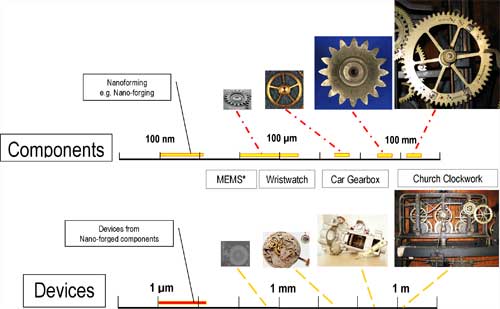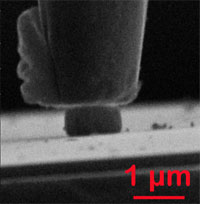| Posted: Mar 07, 2007 | |
From Bronze Age shack to nanotechnology lab - metal forging techniques reach the bottom |
|
| (Nanowerk Spotlight) The earliest forgings, appearing around 1600 BC, were crudely hammered ornaments from naturally occurring free metals. The latest, most state-of-the-art forging techniques use micron-sized hammers to forge nanometer-sized metal shapes to be used as components in nanotechnology and microtechnology systems. New research demonstrates the possibilities of nanoforging - applying conventional metal shaping techniques to nano objects. In recent years, nanoscale fabrication has developed considerably, but the fabrication of free-standing nanosize components is still a great challenge. The ability to produce high-strength metallic components with characteristic dimensions of nanometers by nanoforging opens up new possibilities to eventually produce complex microsystems by assembling free-standing nanoscopic components. At these sizes they are of the same dimensions as micro-organisms and therefore sufficiently small even to travel through the human body. | |
| "We demonstrated the fabrication of metallic nanocomponents utilizing three basic steps" Dr. Debashis Mukherji, a scientists at the Institute for Materials at Technical University Braunschweig in Germany, explains to Nanowerk. "First, we used metallic alloys as factories to produce a metallic raw stock of nano-objects in large numbers. These objects are then isolated from the powder containing thousands of such objects inside a scanning electron microscope using manipulators, and placed on a micro-anvil or a die. Finally, the shape of the individual nano-object is changed by nanoforging using a microhammer. In this way free-standing, high-strength, metallic nano-objects may be shaped into components with dimensions in the 100 nm range." | |
 |
|
| Schematic representation of the steps involved in nanoforging. A metallic alloy is used as a factory to produce metallic raw stock in the form of nano-objects/nanoparticles. One of these nano-objects is isolated and forged to shape a component. (Reprinted with permission from IOP Publishing) | |
| The miniaturization of components and systems is advancing steadily in many areas of engineering and the trend towards ever smaller components and devices is relentless. Today's integrated circuits and MEMS are fabricated in a top-down approach – they are carved out of a monolithic substrate, the size of which is still in millimeter scale. To use bottom-up approaches to build independent, freestanding, complex machines on a micron and submicron scale is still in the realm of speculative fiction at the present state of science and technology. Since, typically, the system to component size ratio in mechanical devices is 10:1, fabricating multicomponent machines on a microscale requires individual components on a nanoscale. | |
 |
|
| The size of toothed gear pinions is compared with the dimensions of the devices they are built in. Over a wide size range, the system to component size ratio is about 10:1. The images of the microgear pinion and the MEMS rotary motor are courtesy of Sandia National Laboratories, SUMMiT Technologies. | |
| Micromanipulation with tools such as micropipettes or lasers is a mature technique for handling microscopic samples in liquids. In contrast, micro- and nano-manipulation in dry environments is still a challenging task due to the absence of liquids to reduce the often strong adhesion forces. In dry environments, scanning probe microscopy (SPM) equipment and mobile microrobots have been previously used to push, slide, and roll nanostructures in two dimensions across surfaces, but this has limited application. Apart from standard SPM tips, more advanced tools like microfabricated grippers could provide better control in manipulation. | |
| Even today, the smallest free standing micro components from metal, polymer or ceramics are still in the size range of 10 to 1000 µm and fabrication of individual free standing components in the nanometer size range is still a big challenge. | |
| Mukherji points out that the new technique has several benefits: "We now demonstrated that objects in the size of 400 nm cube from a high strength intermetallic alloy (e.g. Ni3Al) can be shaped at room temperature. This is of significant scientific interest, because several decades of research to use Ni3Al type intermetallics for high temperature gas turbine applications, still could not solve the problem of using this kind of material (although very attractive for their high temperature properties) in real applications because of their extreme brittle nature at room temperatures, which limits fabrication of components." | |
 |
|
| The nano-object is deformed by a tungsten microhammer on the anvil (a silicon cantilever beam). (Reprinted with permission from IOP Publishing) | |
| On the technological side, this work demonstrates that raw stock can be prepared, handled and manipulated to fabricate submicron-size components, which will make it possible to ultimately fabricate complex devices or machines on a micron scale. | |
| To form complex shapes like for instance a gear wheel from the nanocubes, a shaped die will be needed. The required shape can be engraved, for example by electron-beam lithography, onto the silicon cantilever anvil. The lithographic technique has advanced sufficiently and is now able to produce detailed features on the nanometer scale on monolithic substrates. A counterpart of the die carved out of a silicon wafer can, for example, be fixed to the flat surface of the tungsten hammer, thereby building a closed die forging set up. | |
| The researchers in Braunschweig, under the leadership of Prof. Joachim Rösler are already planning such experiments. | |
| These findings have been published in a recent paper, titled "Forging of metallic nano-objects for the fabrication of submicron-size components", in the February 21, 2007 issue of Nanotechnology. | |
 By
Michael
Berger
– Michael is author of three books by the Royal Society of Chemistry:
Nano-Society: Pushing the Boundaries of Technology,
Nanotechnology: The Future is Tiny, and
Nanoengineering: The Skills and Tools Making Technology Invisible
Copyright ©
Nanowerk LLC
By
Michael
Berger
– Michael is author of three books by the Royal Society of Chemistry:
Nano-Society: Pushing the Boundaries of Technology,
Nanotechnology: The Future is Tiny, and
Nanoengineering: The Skills and Tools Making Technology Invisible
Copyright ©
Nanowerk LLC
|
Become a Spotlight guest author! Join our large and growing group of guest contributors. Have you just published a scientific paper or have other exciting developments to share with the nanotechnology community? Here is how to publish on nanowerk.com.
